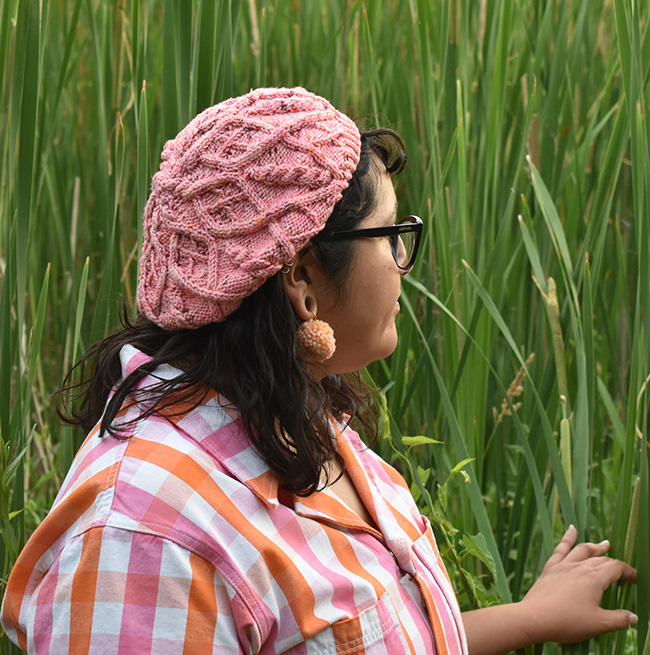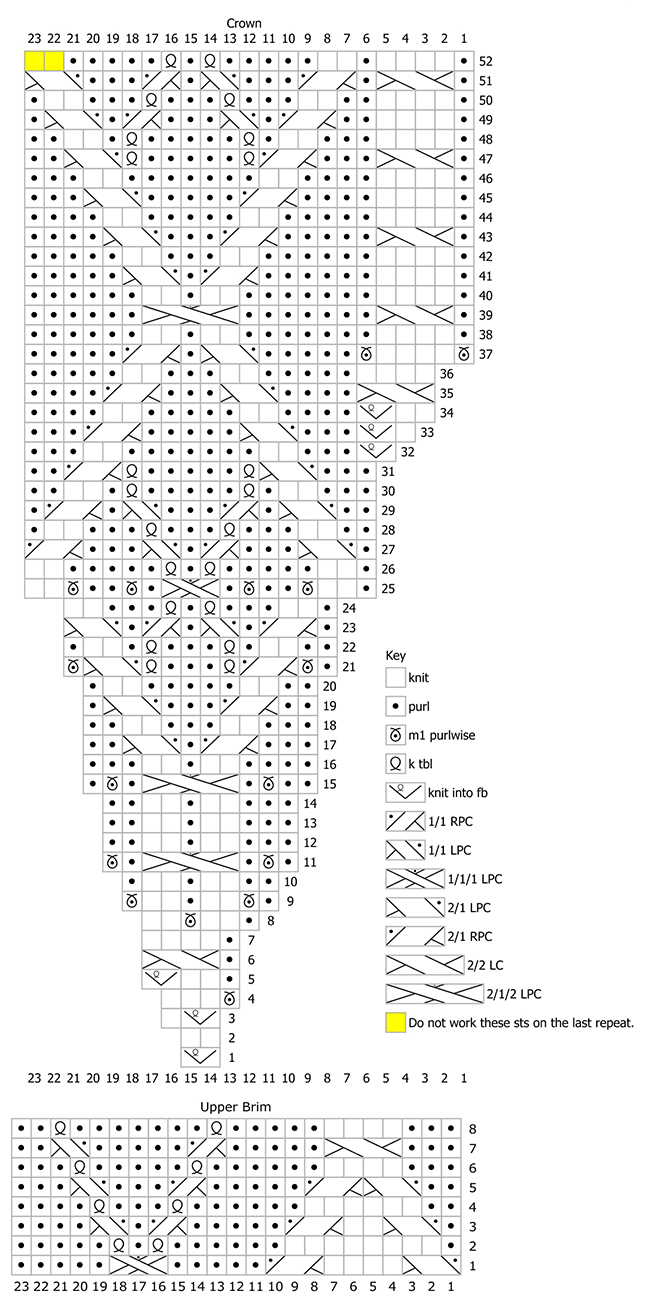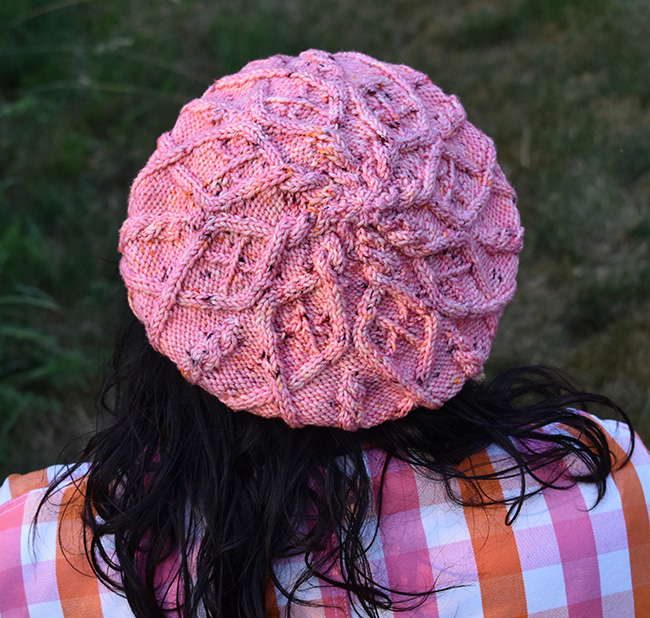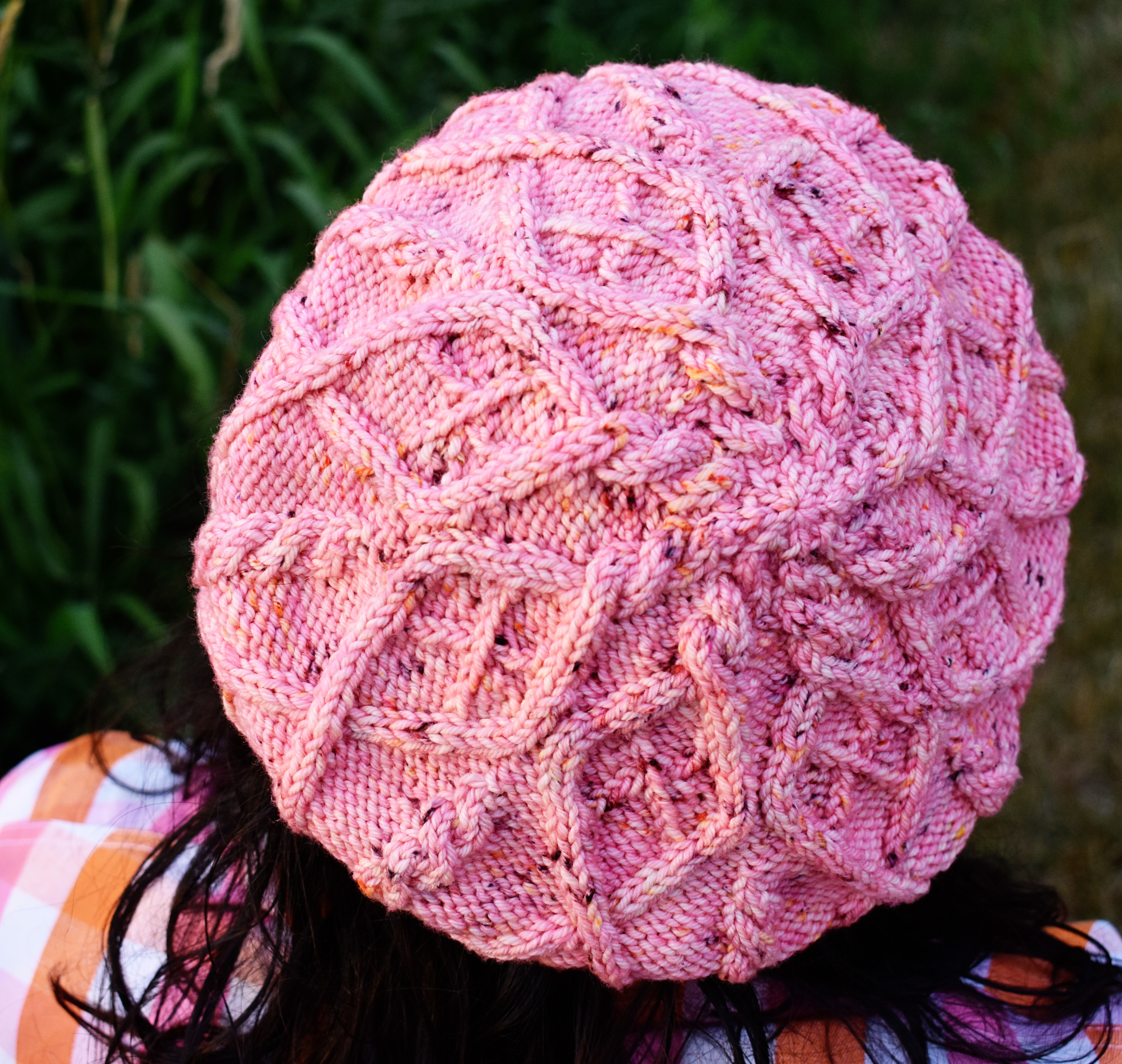What, Like It's Hard?, a free knitting pattern from Knitty.com.
INTRODUCTION
What, Like It's Hard?
 by Alexandra Weston
by Alexandra Weston
![]()
What, Like It's Hard? was inspired by one of my favorite rom coms of all time Legally Blonde. This beret is smart and sophisticated, meets bubbly and of course – pink!
Starting at the top and working its way down, the star of this hat is the twisting cables inspired by the argyle pattern popular in the late 90's and early 2000s. In the movie, the argyle pattern is commonly found on the snobby elite Harvard kids' clothing. Here it's been reimagined into a cable texture that represents the way that Elle was able to learn lessons from her time at Harvard but always put her own spin on things.
 model: Icela Hernandez
model: Icela Hernandez
 photos: Alexandra Weston
photos: Alexandra Weston
SIZE
Adult XS[S, M, L]
Choose a size approximately 0-1.5 inches/0-4 cm smaller than your head circumference measured above your ears.
FINISHED MEASUREMENTS
Head circumference: 16[18.75, 20, 21.5] inches/ 40.5[47.5, 51, 54.5] cm
Diameter of crown: 10 inches/25.5 cm
MATERIALS
Yarn
![]() Madelinetosh Tosh Vintage [Merino Superwash Wool; 200 yd/ 183 m per 3.5 oz/100 g skein]; color: Barbara Deserved Better; 1[1, 1, 1] skein
Madelinetosh Tosh Vintage [Merino Superwash Wool; 200 yd/ 183 m per 3.5 oz/100 g skein]; color: Barbara Deserved Better; 1[1, 1, 1] skein
Yarn Characteristics
![]() The sample is shown in a tight twist superwash yarn with high stitch definition. Though it could look good in a solid, this pattern is best suited to a slightly speckled yarn.
The sample is shown in a tight twist superwash yarn with high stitch definition. Though it could look good in a solid, this pattern is best suited to a slightly speckled yarn.
Recommended needle size
[always use a needle size that gives you the gauge listed below - every knitter's gauge is unique]
![]() 1 US #7/4.5mm needles for small circumference in the round - magic loop, 2 circulars, traditional or flexible DPNs
1 US #7/4.5mm needles for small circumference in the round - magic loop, 2 circulars, traditional or flexible DPNs
![]() 1 US #7/4.5mm circular needles, 16-inch/40 cm
1 US #7/4.5mm circular needles, 16-inch/40 cm
![]() 1 US #6/4mm circular needle, 16-inch/40 cm long
1 US #6/4mm circular needle, 16-inch/40 cm long
Notions
![]() cable needle
cable needle
![]() stitch markers
stitch markers
![]() 1 crochet hook, in the range of size US F-G/3.75-5mm for the cast-on
1 crochet hook, in the range of size US F-G/3.75-5mm for the cast-on

GAUGE
18 sts/24 rounds = 4 inches/10 cm in stockinette stitch
26 sts/36 rounds = 4 inches/10 cm in pattern stitch
29 sts / 60 rounds in Cable pattern repeat measures 3.5 inches / 8.9 cm wide and 7.3 inches / 18.5 cm long
PATTERN NOTES
[Knitty's list of standard abbreviations and techniques can be found here.]
Place stitch markers that are distinctive from your beginning of round marker in between each repeat of the chart.
Construction method: This beret starts at the center point of the crown, which then increases out to its full circumference. It is then knit straight for 2 inches at which point it rapidly decreases. It is then finished off with an inch and a half of twisted rib for the brim of the hat.
Techniques:
- Circular crochet cast-on: Woolly Wormhead has an excellent tutorial.
- An alternative method is shown here.
Cable stitches
1/1 LPC: Slip st to cable needle and hold in front; p1, then k1 from cable needle.
1/1 RPC: Slip st to cable needle and hold in back; k1, then p1 from cable needle.
1/1/1 LC: Slip 2 sts onto cable needle and hold in front; k1, return 1 st from left side of cable needle onto left needle, p1, then k1 from cable needle.
2/2 RC: Slip 2 sts to cable needle and hold in back; k2, then k2 from cable needle.
2/2 LC: Slip 2 sts to cable needle and hold in front; k2, then k2 from cable needle.
2/1 LPC: Slip 2 sts to cable needle and hold in front; p1, then k2 from cable needle
2/1 RPC: Slip 1 st to cable needle and hold in back; k2, then p1 from cable needle.
2/1/2 LC: Slip 3 sts to cable needle and hold in front; k2, return 1 st from left of cable needle onto left needle, p1, then k2 from cable needle.
CHARTS

Crown Pattern
Row 2: K2.
Row 3: Kfb, k1. 3 sts per repeat; 24 sts total.
Row 4: M1p, k3. 4 sts per repeat; 32 sts total.
Row 5: P1, k2, kfb. 5 sts per repeat; 40 sts total.
Row 6: P1, 2/2 LC.
Row 6: P1, 2/2 LC.
Row 7: P1, k4.
Row 8: P1, k2, M1p, k2. 6 sts per repeat; 48 sts total.
Row 9: P1, M1p, k2, p1, k2, M1p. 8 sts per repeat; 64 sts total.
Row 10: P2, (k2, p1) twice.
Row 11: P1, M1p, p1, 2/1/2 LC, p1, M1p. 10 sts per repeat; 80 sts total.
Rows 12, 13, 14: P3, k2, p1, k2, p2.
Row 15: P2, M1p, p1, 2/1/2 LC, p1, M1p, p1. 12 sts per repeat; 96 sts total.
Row 16: P4, k2, p1, k2, p3.
Row 17: P3, 2/1 RPC, p1, 2/1 LPC, p2.
Row 18: (P3, k2) twice, p2.
Row 19: P2, 2/1 RPC, p3, 2/1 LPC, p1.
Row 20: P2, k2, p5, k2, p1.
Row 21: P1, M1p, 2/1 RPC, k1-tbl, p3, k1-tbl, 2/1 LPC, M1p. 14 sts per repeat; 112 sts total.
Row 22: P2, k2, p1, k1-tbl, p3, k1-tbl, p1, k2, p1.
Row 23: P1, 2/1 RPC, p1, 1/1 LPC, p1, 1/1 RPC, p1, 2/1 LPC.
Row 24: P1, k2, p3, k1-tbl, p1, k1-tbl, p3, k2.
Row 25: P1, k2, M1p, p2, M1p, p1, 1/1/1 LC, p1, M1p, p2, M1p, k2. 18 sts per repeat; 144 sts total.
Row 26: P1, k2, p5, k1-tbl, p1, k1-tbl, p5, k2.
Row 27: P1, 2/1 LPC, p3, 1/1 RPC, p1, 1/1 LPC, p3, 2/1 RPC.
Row 28: P2, k2, (p3, k1-tbl) twice, p3, k3.
Row 29: P2, 2/1 LPC, p1, 1/1 RPC, p3, 1/1 LPC, p1, 2/1 RPC, p1.
Row 30: P3, k2, p1, k1-tbl, p5, k1-tbl, p1, k2, p2.
Row 31: P3, 2/1 LPC, k1-tbl, p5, k1-tbl, 2/1 RPC, p2.
Row 32: Kfb, p3, k2, p7, k2, p3. 19 sts per repeat; 152 sts total.
Row 33: K1, kfb, p3, 2/1 LPC, p5, 2/1 RPC, p3. 20 sts per repeat; 160 sts total.
Row 34: K2, kfb, p4, k2, p5, k2, p4. 21 sts per repeat; 168 sts total.
Row 35: 2/2 LC, p4, 2/1 LPC, p3, 2/1 RPC, p4.
Row 36: K4, p5, k2, p3, k2, p5
Row 37: M1p, k4, m1p, p5, 2/1 LPC, p1, 2/1 RPC, p5. 23 sts per repeat; 184 sts total.
Row 38: P1, k4, p7, k2, p1, k2, p6.
Row 39: P1, 2/2 LC, p7, 2/1/2 LC, p6.
Row 40: P1, k4, p7, k2, p1, k2, p6.
Row 41: P1, k4, p6, 2/1 RPC, p1, 2/1 LPC, p5.
Row 42: P1, k4, p6, k2, p3, k2, p5.
Row 43: P1, 2/2 LC, p5, 2/1 RPC, p3, 2/1 LPC, p4.
Row 44: P1, k4, p5, k2, p5, k2, p4.
Row 45: P1, k4, p4, 2/1 RPC, p5, 2/1 LPC, p3.
Row 46: P1, k4, p4, k2, p7, k2, p3.
Row 47: P1, 2/2 LC, p3, 2/1 RPC, k1-tbl, p5, k1-tbl, 2/1 LPC, p2.
Row 48: P1, k4, p3, k2, p1, k1-tbl, p5, k1-tbl, p1, k2, p2.
Row 49: P1, k4, p2, 2/1 RPC, p1, 1/1 LPC, p3, 1/1 RPC, p1, 2/1 LPC, p1.
Row 50: P1, k4, p2, k2, p3, k1-tbl, p3, k1-tbl, p3, k2, p1.
Row 51: P1, 2/2 LC, p1, 2/1 RPC, p3, 1/1 LPC, p1, 1/1 RPC, p3, 2/1 LPC.
Row 52: P1, k4, p1, k2, p5, k1-tbl, p1, k1-tbl, p5, k2; note: on final repeat, end before the final k2.
Upper Brim Pattern
Row 2: P1, k8, p6, k1-tbl, p1, k1-tbl, p5.
Row 3: P1, 2/1 LPC, k2, 2/1 RPC, p5, 1/1 RPC, p1, 1/1 LPC, p4.
Row 4: P2, k6, p6, k1-tbl, p3, k1-tbl, p4.
Row 5: P2, 2/1 LPC, 2/1 RPC, p5, 1/1 RPC, p3, 1/1 LPC, p3.
Row 6: P3, k4, p6, k1-tbl, p5, k1tbl, p3.
Row 7: P3, 2/2 LC, p5, 1/1 RPC, p5, 1/1 LPC, p2.
Row 8: P3, k4, p5, k1tbl, p7, k1-tbl, p2.
DIRECTIONS

Crown
Using larger needles for small circumference in the round and crochet method, cast on 8 sts. Clip a removable stitch marker near the start of the round and join for working in the round.
Crown round: Work Crown Shaping pattern 8 times around.
If you're working on DPNs, as the stitch count increases, you may wish to change to the larger 16 inch/40 cm circular needle.
Work until you have completed Round 51, and then work Round 52, stopping 2 stitches short of the end of the round. This position will be the new start of round. Place a marker here, removing the previous start of round marker as you pass it next time. 184 sts.
Working from chart or written instructions as you prefer, begin Upper Brim Pattern. The repeat is worked 8 times around.
Work as set until Upper Brim Pattern is complete.
Brim
Switch to smaller circular needle.
Decrease round, XS only: [(K2tog, p2tog) 10 times, k3tog, p3tog] to end of
round. 88 sts.
Decrease round, S only: [(K2tog, p2tog) 11 times, k1, p1] to end of round. 96 sts.
Decrease round, M only: [(K2tog, p2tog) 9 times, (k1, p1) 5 times] to end of
round. 112 sts.
Decrease round, L only: [(K2tog, p2tog) 8 times, (k1, p1) 7 times] to end of
round. 120 sts.
Ribbing: (K1-tbl, p1) around.
Work Ribbing as set for 1.5 inches/4 cm.
Bind off, using the larger needle to work the stitches in pattern as you go.

FINISHING
Weave in ends and wet block, by soaking the garment, squeezing out the excess water and stretching the crown of the hat over a dinner plate (approximately 10 inches/25.5cm in diameter). Allow the garment to dry completely before removing it from the plate.
ABOUT THE DESIGNER
 Alexandra has been knitting for 17 years. After years of writing patterns for herself, she began self-publishing designs in 2022. She was a full-time knitting teacher for 4 years before moving to Tennessee to help her sister start an alpaca farm. Knitty is her first professional publication (so far!).
Alexandra has been knitting for 17 years. After years of writing patterns for herself, she began self-publishing designs in 2022. She was a full-time knitting teacher for 4 years before moving to Tennessee to help her sister start an alpaca farm. Knitty is her first professional publication (so far!).
Follow her on Instagram.
Pattern & images © 2023 Alexandra Weston









